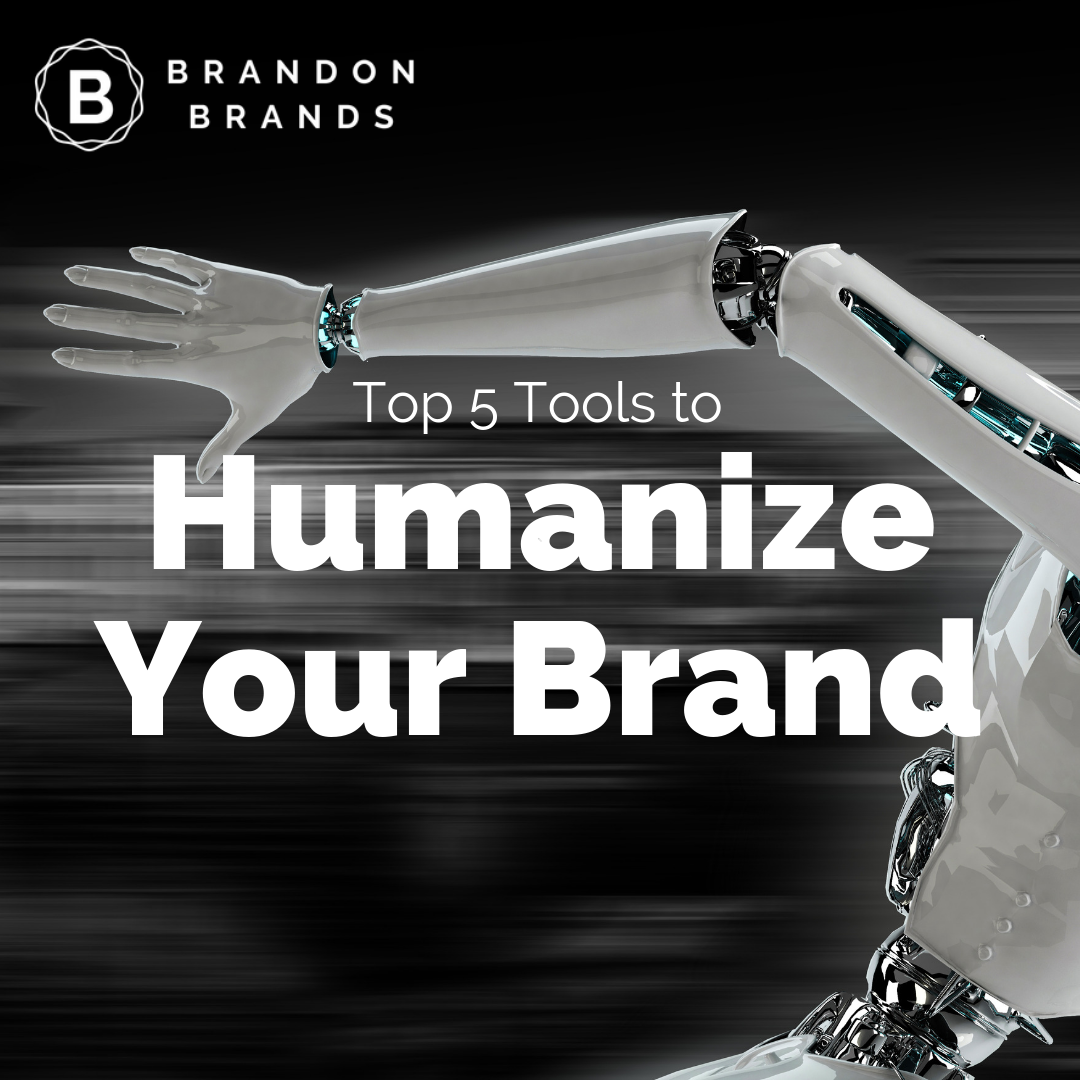
Live Video, Text, Email, Messenger, and Social Media.
Sometimes technology can makes us better, and sometimes it can make us worse. That is certainly the case in marketing. We have these amazing tools and access to insane amounts of data, but we don’t always use it in a way that is best for us long term.
The biggest advantages we can derive from today’s technology and data are:
- A better understanding of our customers
- Insights into what is working and what is not
- Automated communication to save us time for redundant tasks
- Real time live communication and feedback
And we have amazing communication tools that are perfect for being more human and personalized in the way we communicate. My five favorites are live video, text, email, messenger, and social media comments. Each of these are real-time, direct communication that we can customize to speak to our customers one person at a time.

With live video, you can jump on a stream like Youtube live, Facebook live, Instagram live or even LinkedIn Live now and communicate with your customers. And those customers can join the conversation live and ask you questions or engage in conversation. And the one’s that don’t join live and watch later and add their comments as well. They get to engage with the rest of the community as well at the same time. What a powerful tool for a business if you actually take the time to learn how to use it.
Text, email messaging, and messenger programs have been around for a long time. It’s still one of the more effective ways to own a relationship with your customers and deliver value. But too many times, we neglect these channels and send out mass messages that spam our audience. This is where we can step up and be highly targeted in separating our messages out based on what we know about our customers.
With so many people doing it wrong, it’s easy to stand out when you do it right.
And social media is now a standard part of our communication mix. It’s massively adopted and has allowed consumers direct communication with the brands they love or don’t love. It’s where customers feel safe voicing their opinions about your business. And it’s here that you can step up and be responsive.
Too many people focus on how they can be posting more often and creating content, but the first thing they should do is make sure they have a system in place to respond to each and every customer that chooses to interact with them. Otherwise you are missing the point.

But even with all these amazing advantages, it becomes very easy to fall into some bad habits. Just think about how many bad ads you’ve seen. Or how many times have you received an ad for something ten times in a row even though you are not in the market for it. Or my favorite, how often to you receive generic messages that you just completely ignore or discard as spam.
The funny thing is, when you lay it out, most of us know the right answers but don’t apply them. We know we need to be more personalized with our communication, but as a business scales, we start to take the easier roads so we can cross one more thing off of our never ending to do list.
If you don’t take the time to create messaging that actually speaks directly to people as human individuals, you are completely wasting your time.
We are too smart to be tricked by marketing. Real connection is your only path forward.
Branding in the traditional sense has died. And it was the internet that killed it. Once customers could instantly compare products and services, they no longer needed a brand to tell them who to trust. They can find all the details right there online, along with real customer reviews, pricing, and competitive alternatives.
The role of branding has changed. A brand is no longer a well crafted story built to convince and convert. A brand now is truly a reflection of a companies values, actions, and the popular perception of the community.
To build brands that matter in this type of environment takes effort, feedback, optimization, and self-reflection. But if you are willing to make the effort you can reap the rewards of customer satisfaction and loyalty.
Now let’s talk some more about those key advantages:
A Better Understanding of Our Customers

We have more data than ever before on our customers. Most of the time they are happy to give you their information, or even better their feedback if you take the time to ask and provide a fair value exchange. But many marketers take this information, interpret it into their offerings and spit back out a improved product, but not an improved marketing action. Specifically, many advertisers stick to just a few core messages rather than getting more personalized. If you know all this information about your customers, you should use it to understand them better and craft not just 3 messages, but how about 20, or 100, or 1000!
Now don’t start freaking out about the production costs or time involved in creating this many ads. Start with smaller numbers and then add as you can. Design ads intentionally to speak to less people more specifically. If you don’t, they are going to ignore it anyway. It’s better to effectively reach less people than to scream at more people who aren’t listening.
Insights into What Is Working and What Is Not

Another great advantage is that you can see what’s working in real time. With so much of our advertising efforts moving online, we can actually see what’s driving business.
The problem here is still that we are taking the easy way out. We pick a few topline metrics that are easy to report and set them as the benchmarks. The better thing to do is to look at every metric from beginning to end and see at each stage what can be improved. Maybe the problem is the copy, maybe it’s the picture, maybe it’s the landing page, maybe it’s the offer. You have to keep tracking and tweaking to see what works.
And you can test things at a smaller scale before you roll out to a larger audience. You can save so much money and trouble by rolling out new ideas in smaller batches. How many embarrassing and controversial TV ads could have been fixed if they had tested them to a real audience on a smaller scale first. What if you designed ads for online first and then adapted them for broad reach formats? Imagine how much more effective you’d be with your broader umbrella messaging, especially if it was supported by 1000 other specifically targeted messages.
Automated Communication to Save Us Time From Redundant Tasks

With all the data out there, we get to know very quickly what types of questions people are asking over and over again and we can answer them. We can put those answers into a well drafted FAQ page on our website, or into a community forum environment. We can arm our customer service staff with those answers, and we can populate auto-responders and bots with those responses.
But when we get lazy, we stop there. We forget to make sure there is a human option. We always need an easy way to talk to a real person and we want to be invited to give real feedback. There have to be places for real conversation to live and breathe. That community can be created and managed by your company. You can control the conversation and show that you value that community. Or you can watch from the sidelines as your customers create their own community and conversations about you without you there to provide value. I’m sure you know how that goes. It’s not a good look.
Building these processes is easier than ever. But like most things in marketing, you can not build it and walk away. You have to set up a system for checking and adapting the processes as they will grow and change.
Real-Time Live Communication and Feedback

What an amazing time we live in that we have access to instant and live communication across multiple platforms and media types. You can pick up a phone, jump on a video call, type into a forum, or direct message at a moments notice.
It’s the responsibility of a business to figure out how to be prepared to interact with this many forms of communication and be responsive.
In fact, you can take the extra step and proactively communicate news and provide commentary with your community at your own discretion. You can jump on a live video platform right now and just let your customers know how happy you are that they are a part of your community. You can ask them a quick question, or send them a survey. You can make announcements and provide updates or share content. You can be your own media company in a matter of seconds.
But you need to take the time to understand what you want to communicate and how you want to represent yourself before you put yourself out there. How you communicate these days is a big part of how your brand is perceived.
So just like you would in real life, think about what you are going to say before you say it. And if you make a mistake, genuinely and quickly apologize. You don’t have to be perfect, but you do have a responsibility to connect and communicate with your community in a way that adds value.
Check out my Free Online Branding Checklist to get tips on how to get your business found online!
Brandon Birkmeyer is the host of the Brands on Brands on Brands Podcast. I believe that building brands that matter today is the only way for a business to thrive tomorrow. Brands that are true to a purpose. Brands that put people first. Brands that build real connections.